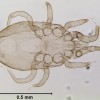Abstract
The chicken mite affects egg-laying hens in many parts of the world, including Europe, Japan, China, and the United States. Although Dermanyssus gallinae affects birds in many regions, it is most prevalent in European countries, where egg industry losses are estimated at $177 million per year. It is a known vector for the St. Louis encephalitis virus, as well as other illnesses, such as fowl pox virus, Newcastle virus, and fowl cholera. In the United States, Dermanyssus gallinae is rarely found in caged-layer operations and is more commonly found in breeder farms. This 3-page fact sheet was written by Ethan Carter and Jennifer L. Gillett-Kaufman, and published by the UF Department of Entomology and Nematology, December 2014. (Photo credit: Lyle J. Buss, University of Florida)
References
Chauve C. 1998. The poultry red mite Dermanyssus gallinae (De Geer, 1778): Current situation and future prospects for control. Veterinary Parasitology 73: 239-245. https://doi.org/10.1016/S0304-4017(98)00167-8
George D, Smith T, Shiel R, Sparagano O, Guy J. 2009. Mode of action and variability in efficacy of plant essential oils showing toxicity against the poultry red mite, Dermanyssus gallinae. Veterinary Parasitology 161: 276-282. https://doi.org/10.1016/j.vetpar.2009.01.010
Hoy MA. 2011. Agricultural acarology: Introduction to integrated mite management. CRC Press, Boca Raton, FL, pp. 325-327.
Mul M, Niekerk V, Chirico J, Maurer V, Kilpinen O, Sparagano O, Thind B, Zoons J, Moore D, Bell B, Gjevre A, Chauve C. 2009. Control methods for Dermanyssus gallinae in systems for laying hens: Results of an international seminar. World's Poultry Science Journal 65: 589-600. https://doi.org/10.1017/S0043933909000403
Proctor H, Owens I. 2000. Mites and birds: Diversity, parasitism and coevolution. Trends in Ecology and Evolution 15: 358-364. https://doi.org/10.1016/S0169-5347(00)01924-8
Roberts V. (2014). Diseases of farmyard poultry part 4 - External and internal parasites of chickens. National Animal Disease Information Service. http://www.nadis.org.uk/bulletins/diseases-of-farmyard-poultry/part-4-external-and-internal-parasites-of-chickens.aspx. Retrieved July 15, 2014.
Ruff M. 1999. Important parasites in poultry production systems. Veterinary Parasitology 84: 337-347. https://doi.org/10.1016/S0304-4017(99)00076-X
Sparagano O, George D, Harrington D, Giangaspero A. 2014. Significance and control of the poultry red mite, Dermanyssus gallinae. Annual Review of Entomology 59: 447-466. https://doi.org/10.1146/annurev-ento-011613-162101

